What’s a Non-Use Agreement
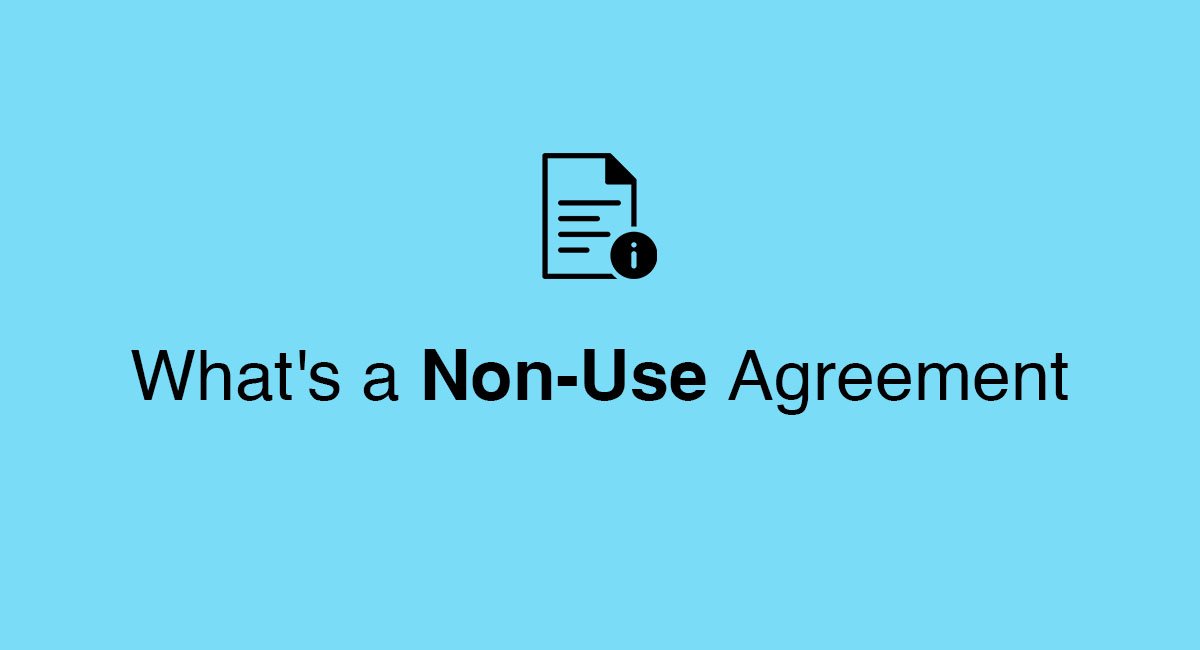
Whether you’re a Fortune 500 company like St Jude Medical whose trade secrets were stolen by an ex-employee engineer or a supermodel like Naomi Campbell whose personal assistant shared personal information about her to the media without Ms Campbell’s permission, the importance of ensuring that parties you work with don’t misuse confidential information without your authorization is of obvious importance.
In your search for solutions, legal protection and tools to protect your proprietary information, you may have across something called a “non-use agreement.”
So what’s this non-use agreement exactly?
Contents
The Non-Use Agreement
A non-use agreement is normally found between parties that are trying to restrict the use of information that’s disclosed without authorization.
Examples where non-use agreements are particularly useful is when you intend to share intellectual property with another party but you want to ensure that you retain all rights to the information.
Or, when you’re considering hiring an employee who will have access to top secret information and you’re worried that she/he may use the information for the benefit of his or her next future employer.
Non-use agreements can be very useful but they are generally not as commonly used as the non-disclosure agreements.
The Non-Disclosure Agreement (NDA)
An NDA (a non-disclosure agreement) is also known as a confidentiality or trade secret agreement but essentially, it’s a legally binding contract between parties that requires them to keep certain information confidential and not to misuse that confidential information.
So, how is a non-use agreement different from a non-disclosure agreement?
Actually these agreements are essentially the same because non-use agreements are normally combined with NDA agreements anyway.
Generally, an NDA encompasses the provisions (clauses) of a non-use agreement but also prohibits disclosure or sharing of that information with non-authorized parties and vice versa.
Here’s an example of a University of Connecticut‘s non-use provision in its Non-Disclosure and Non-Use agreement:
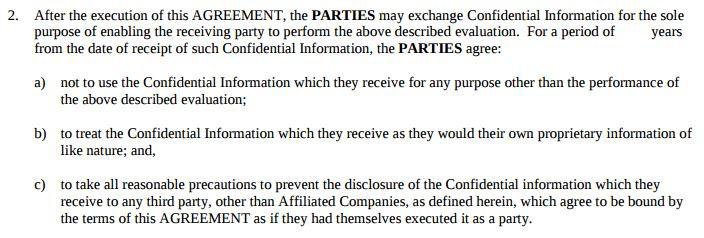
Another example from a Confidential Disclosure and Non-Use Agreement by The John Hopkins University Applied Physics Laboratory where the non-use clause is essentially combined together with a non-disclosure clause:

Notice the similarity of intention in the above clauses with the clause in this Confidentiality and Non-Disclosure Agreement by Accuride Corp:
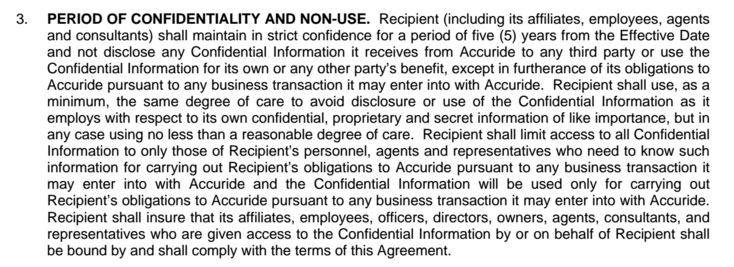
Here’s another example from the Mutual Non-Disclosure Agreement by Thoughtbot:

You can see that although the agreements may have different titles, the agreements essentially say the same thing although the NDA is more commonly used and well-known.
The non-disclosure agreement is better
NDA agreements can be used to protect a wide range of confidential information including trade secrets.
Startups, individuals, small and medium-sized enterprises (SMEs) and larger corporations love to use these kind of agreements when trying to establish a new business relationship, partnership or employment relationship with another party. In the event of a breach of confidentiality, NDAs can provide for both monetary remedies as well as injunctive and equitable relief to stop any further breaches from occurring.
Examples where NDAs are commonly used are in top-level employer-employee hiring situations, between parties who are considering entering into a licensing agreement with each other, distribution relationships and between startups and companies who wish to gauge the potential possibility of beneficial commercial partnerships.
These kind of agreements can go both ways or be only one-way.
A mutual NDA is where both parties are making disclosures that need to be kept confidential by the other party whilst the one-way agreement is where only one party is intending to make disclosures and the other party is required to maintain secrecy and not misuse the information (“Receiving Party”).
The purpose of the agreement
Providing a purpose for your NDA is extremely important in ensuring that the terms of your agreement are reasonable. Not all disclosures are created equal and not all disclosures might be considered confidential information.
As an example, here’s a “Statement of Limited Purpose” from Microsoft in its Confidentiality Agreement for Licensing Discussions to clarify what disclosures the agreement is meant to apply to:

What’s your Confidential Information
Besides the purpose of the NDA, courts also frequently consider whether the definition of what’s considered confidential is reasonable and not too broad.
Confidentiality can extend to documents, designs, prototypes, analyses, source codes, experimental results, manufacturing processes and technical procedures.
It’s up to the parties involved to decide what would be considered confidential and what is not, but it should be justifiable by the disclosing party why something might be considered confidential.
Here’s an example of a clause defining what would be considered confidential for the parties in Accuride Corp’s Confidentiality and Non-Disclosure Agreement.

The reasonable scope of the agreement
Especially in certain countries and states, there’s nothing that the courts enjoy more than striking down an agreement that’s unreasonably onerous or one that comes across as too anti-competition.
Don’t make your NDA overly restrictive if it doesn’t meet your business objectives.
An example of unreasonable restrictiveness could be demanding that confidentiality be preserved indefinitely when the confidential information doesn’t warrant it or not allowing an employee to ever obtain employment in the same industry.
Where a clause or agreement is considered too burdensome, courts have been known to strike down the particular offending clause or to declare the whole agreement unenforceable.
An example where the court decided to declare the whole NDA invalid was a Virginia court in Lasership, Inc. v. Watson. There, the court was influenced by the fact that the definition of confidentiality in the NDA was too broad and also that the duration of the confidentiality was stated to apply for the rest of the employee’s life.
Your exceptions to the requirement for confidentiality
To ensure that an NDA is deemed reasonable and to avoid the risk of it being invalidated, the Disclosing Party normally provides these following exceptions to the requirement for confidentiality:
-
Information that was provided by a third party prior to the disclosure.
One of the exceptions that an NDA normally excludes from its requirement of secrecy is information that was provided to the Receiving Party by a third party independently prior to your disclosure.
For example, the Receiving Party may have received the confidential information through an independent supplier prior to you making the disclosure.
If that is the case, it would be unreasonable for you to demand that the Receiving Party keep that information confidential when the information was provided by an independent party.
-
Information already known by Receiving Party or in public domain.
The main purpose of an NDA is to keep information that’s still confidential, a secret.
However, if through no breach or fault of the Receiving Party, the confidential information enters the public domain, that same piece of information would no longer be considered confidential.
For example, if your information gets published by an aggrieved employee into the public domain, you cannot enforce an NDA covering the same leaked information against the Receiving Party.
Similarly, if you deal with 5 different partners and have only requested 4 of your partners to sign NDAs, but omitted to do so with the last partner and he or she leaked your confidential information to the public, all previous NDAs with the earlier 4 partners are now invalid as the information has entered the public domain.
Therefore, if you intend to keep information confidential, all parties that deal with the information should be required to sign NDAs.
-
The Receiving Party of your confidential information had managed to develop the information independently prior to your disclosure.
Oftentimes, you may choose to collaborate with a Receiving Party that is in the same line of work that you do.
For example, if you were a hardware developer, you may choose to collaborate with another hardware developer. It’s highly likely that the other hardware developer would have made discoveries on their own prior to your collaboration.
In this case, the confidential information that the hardware developer created on their own independently cannot be part of the NDA, even if it’s similar to yours and you cannot claim proprietary interest over that particular piece of information.
What are your exceptions for any court-ordered or legally compelled disclosures
There have been occasions where certain parties, such as the government, have been granted the right to force a Receiving Party to disclose confidential information.
For example, the U.S. Government successfully managed to gain access to Jacob Appelbaum, a volunteer of WikiLeaks’s emails in its investigation of Wikileaks. Despite being upset, Jacob Appelbaum was forced to comply.
Although your Receiving Party may choose not to resist the court order for disclosure, you should at least request that the Receiving Party give you sufficient notice of the order received to enable you to seek legal protective remedies or at the very least to cooperate with you to limit the amount of disclosure necessary.
An example of a clause that provides for all these exceptions can be found in the University of Connecticut’s Non-Disclosure and Non-Use agreement:
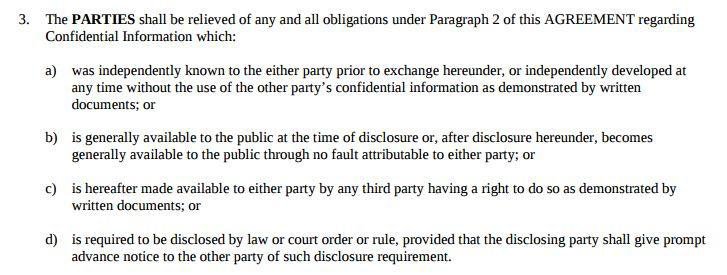
What’s the jurisdiction of your agreement
In the event that you have to enforce the NDA against an errant Receiving Party, the jurisdiction that applies to your NDA will be crucial. You will want to choose a jurisdiction that will look at the provisions more favourably, especially if you intend to use particularly restrictive provisions.
Here is an example of a clause that allows you to specify your jurisdiction from a template NDA from Harvard Business School:

The termination of relationship
Your contractual relationship will eventually have to terminate at some point, whether by natural progression or because you don’t wish to continue working together anymore. It is particularly important that you specify what obligations the Receiving Party has in terms of the confidential information that they have already been given.
Most NDAs provide that parties have to return all copies or destroy any in their possession.
An example of such a clause can be found in Thoughtbot’s Mutual Non-Disclosure Agreement:

Combining non-disclosure with non-compete and non-solicitation
Besides non-use clauses, there are also other types of clauses that may help you achieve your objectives.
Similar to a non-disclosure / non-use agreement, a non-compete clause prevents the Receiving Party from competing with you for a specific period of time and in a certain geographic location.
However, the terms of your non-compete clause has to be reasonable as courts loathe to uphold something that comes across as an unfair restraint on commercial competition.
For example, if you were in a dentistry business, you could require that the other party not set up any competing dentistry businesses for the next 2 years within your city.
A non-solicitation clause basically prevents the Receiving Party from poaching your employees and customers. This is especially important if the Receiving Party has built a great relationship with other employees in your business and is well-liked amongst customers.
An example of a combined non-competition and non-solicitation clause can be found in Coca Cola’s Agreement on Confidentiality, Non-Competition and Non Solicitation:
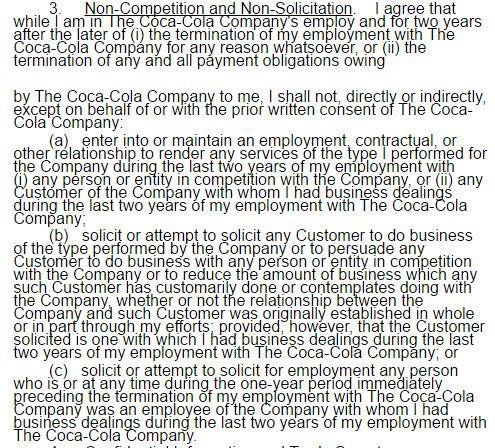
As you can see, the NDA can wear many different hats and incorporate non-use, non-compete and non-solicitation clauses.
However, always try to keep restrictions on the Receiving Party to a minimum to lessen the risk of your NDA being declared invalid by an unfavorable court.
Remember that you need to be prepared to justify the reason for a particular restriction.
Credits: Icon Information File by Pham Thi Dieu Linh from Noun Project.
Nov 15, 2017 | Other Agreements
This article is not a substitute for professional legal advice. This article does not create an attorney-client relationship, nor is it a solicitation to offer legal advice.